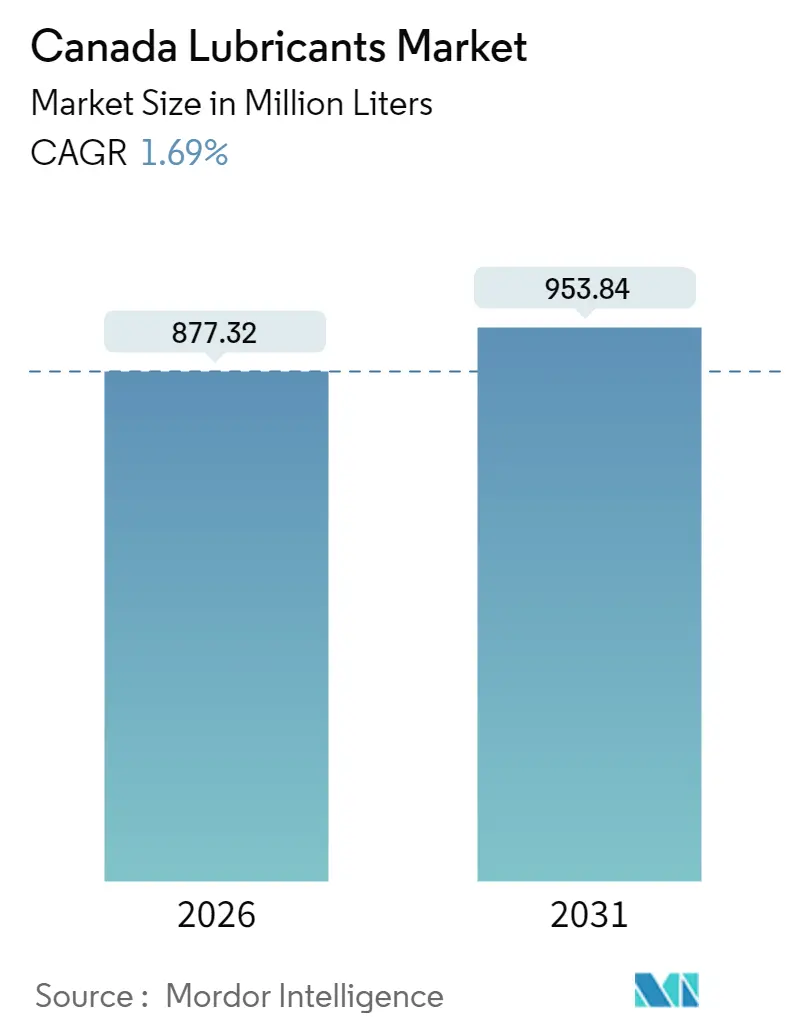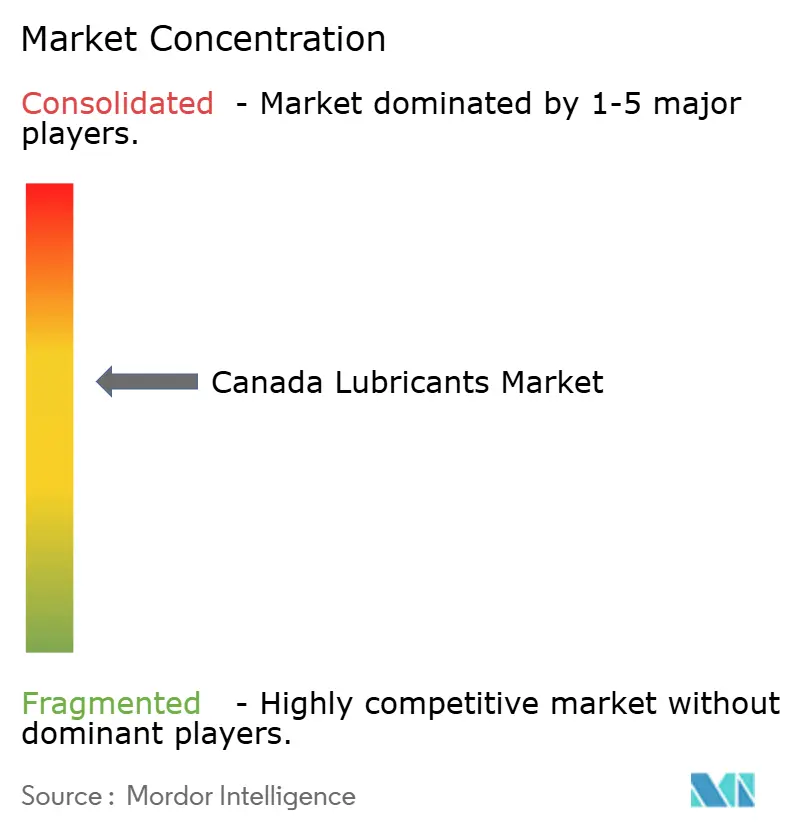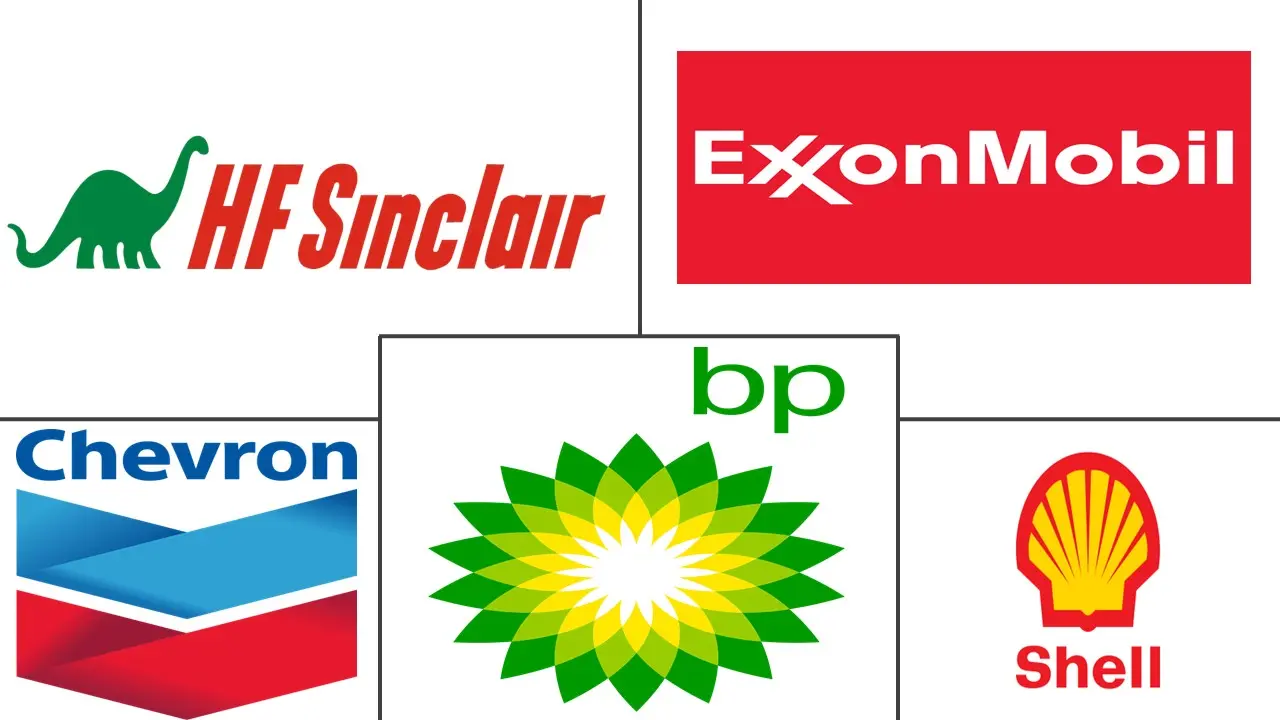
Canada Lubricants Market Analysis by Mordor Intelligence
The Canada Lubricants Market is expected to grow from 862.73 million liters in 2025 to 877.32 million liters in 2026 and is forecast to reach 953.84 million liters by 2031 at 1.69% CAGR over 2026-2031. This steady trajectory reflects the push-and-pull between established industrial demand, ongoing oil-sands activity, and headwinds from the transition to transport electrification. In 2024, passenger and commercial vehicles together generated more than half of total consumption, yet the market’s center of gravity is already tilting toward industrial, marine, and off-highway sectors that face no immediate electrification substitute. North American base-oil prices slipped USD 0.15-0.50 per gallon in late-2024, placing margin pressure on blenders but also spurring efficiency investments, strategic bulk purchasing, and renewed distributor consolidation. Synthetic and bio-based formulations are carving out higher-margin niches as Environment and Climate Change Canada’s phased PFAS restrictions compel rapid reformulations. Meanwhile, long-cycle mining projects, high-horsepower marine engines, and renewable-diesel process units provide resilient, high-value outlets for specialty lubes, shielding the Canada lubricants market from an outright volume contraction.
Key Report Takeaways
- By product type, Automotive Engine Oil led with 38.92% of Canada lubricants market share in 2025, while Industrial Engine Oils is forecast to expand at a 2.21% CAGR to 2031.
- By end-user industry, the automotive sector held 50.58% of total demand in 2025, while marine applications are projected to advance at a 4.43% CAGR through 2031.
- By base stock type, mineral-based products accounted for 58.32% share of the Canada lubricants market size in 2025; bio-based lubricants are projected to grow at an 8.15% CAGR between 2026 and 2031.
Note: Market size and forecast figures in this report are generated using Mordor Intelligence’s proprietary estimation framework, updated with the latest available data and insights as of January 2026.
Canada Lubricants Market Trends and Insights
Drivers Impact Analysis
| Driver | (~) % Impact on CAGR Forecast | Geographic Relevance | Impact Timeline |
|---|---|---|---|
| Growing Sales of Motor Vehicles | +0.3% | National, concentrated in Ontario manufacturing belt | Medium term (2-4 years) |
| Increasing Demand from Manufacturing Industry | +0.4% | Ontario, Quebec manufacturing centers, Alberta petrochemicals | Long term (≥ 4 years) |
| Shift Toward High-Performance Synthetic Lubricants | +0.2% | National, premium segments in urban markets | Long term (≥ 4 years) |
| Expansion of Mining and Oil-Sands Operations | +0.6% | Alberta oil sands, Saskatchewan potash, British Columbia metals | Short term (≤ 2 years) |
| Rising Adoption of Energy-Efficient Hydraulic Systems | +0.2% | National industrial applications, construction equipment | Medium term (2-4 years) |
| Source: Mordor Intelligence | |||
Growing Sales of Motor Vehicles
New-vehicle registrations rebounded in 2024, and after-sales networks are scaling to meet service demand. Valvoline Great Canadian Oil Change, now at 130 sites, topped the J.D. Power service index with a score of 834[1]Valvoline Inc., “Great Canadian Oil Change Network Expansion,” valvoline.com . Federal backing of Project Arrow signals ongoing domestic assembly, while Ontario’s modernization grants of up to CAD 150,000 per supplier are encouraging precision machining that needs premium cutting fluids. Electric-vehicle uptake is not shrinking lubricant volumes; it is redistributing them toward specialized transmission and coolant products designed for high dielectric strength. The trend is expected to keep the Canadian lubricants market on a steady replacement cycle rhythm, even as average drain intervals lengthen.
Increasing Demand from Manufacturing Industry
Manufacturing contributes about CAD 174 billion to GDP and is targeting productivity gains of 2.5%–9.9% over three years. The Advanced Manufacturing Cluster has earmarked CAD 427 million for automation and additive projects, all of which rely on thermally stable hydraulic and spindle oils. Digital-adoption grants of CAD 15,000 are nudging SMEs toward high-speed CNC systems that require low-mist metalworking fluids. Energy-management programs show friction-reduction savings of up to 6% when synthetic gear oils replace mineral grades, helping justify their price premium. These upgrades directly enlarge the addressable pool for the Canada lubricants market.
Shift Toward High-Performance Synthetic Lubricants
The ILSAC GF-7 specification, effective March 31 2025, mandates lower volatility and improved low-speed pre-ignition protection, effectively steering buyers to synthetics. Laboratory data reveal 6% fuel-economy gains for heavy-duty fleets when switching to full PAO formulations. Research on canola-ester bases enhanced with liquid-crystal additives records lower wear scars than conventional hydraulics, positioning bio-synthetics as viable drop-ins for sensitive sites. Although synthetic SKUs cost up to 300% more, operators report 30% shorter maintenance windows and 50% fewer thermal cleanouts. These advantages underpin the long-term pull on the Canada lubricants market.
Expansion of Mining and Oil-Sands Operations
Capital budgets exceeding CAD 30 billion in 2024 are expanding oil-sands output toward all-time highs, with Canadian Natural Resources targeting 600,000 barrels per day after upgrader debottlenecking. The Albian complex has approvals to double its current run-rate, which will intensify the need for extreme-pressure open-gear greases and drill-rod coatings. A decade-high 6,604 wells are forecast for 2025, each relying on high-vis synthetic drilling oils that resist water washout. Sub-sea Arctic projects require fluids that hold viscosity below –40 °C and limit ecotoxicity, driving R&D toward self-lubricating composites. These developments are central to volume growth in the Canada lubricants market.
Restraints Impact Analysis
| Restraint | (~) % Impact on CAGR Forecast | Geographic Relevance | Impact Timeline |
|---|---|---|---|
| Risks Associated with Lubricating Oils | -0.2% | National, concentrated in industrial and automotive applications | Medium term (2-4 years) |
| Volatility in Base-Oil Prices | -0.4% | National supply chain, refinery-dependent regions | Short term (≤ 2 years) |
| Tightening PFAS and ZDDP Environmental Regulations | -0.3% | National regulatory compliance, industrial sectors | Long term (≥ 4 years) |
| Source: Mordor Intelligence | |||
Risks Associated with Lubricating Oils
ZDDP remains indispensable for wear protection, yet its phosphorus can poison catalytic converters, pressing OEMs to cap additive doses[2]American Chemical Society, “ZDDP Additive Review,” acs.org . Canadian assessments flag methyl-benzothiazole as toxic, prompting substitution in anti-corrosion packages. Food-grade, marine, and forestry users face the toughest balance between biodegradability and load-carrying capacity. The technical challenge of finding cost-effective, non-toxic replacements may slow innovation tempo and impose higher formulation costs, trimming short-term momentum in the Canada lubricants market.
Volatility in Base-Oil Prices
Petroleum accounts for 31% of national greenhouse-gas output, and decarbonization policies are diverting refinery investments toward renewable fuels, tightening domestic Group I and II supply. Feedstock upheavals from geopolitical events add spot-price swings that compress blender margins and complicate customer budgeting. Bio-based stocks are not yet scale-competitive on cost because of feedstock competition and processing yields. These uncertainties can delay large-volume purchase commitments, tempering growth in the Canada lubricants market.
Segment Analysis
By Product Type: Engine-Oil Leadership Meets Industrial Upswing
Automotive engine oils retained 38.92% of Canada lubricants market share in 2025, underscoring the segment’s historic weight even as electrification advances. Industrial engine oils are smaller in absolute volume but are poised to outgrow the market at a 2.21% CAGR, driven by oil-sands generators, diesel compressors, and shale-gas prime movers. Transmission and hydraulic fluids benefit from construction equipment re-fleeting; gear oils hold steady in forestry skidders and marine reduction boxes, where ISO VG 680 synthetics rival straight mineral 90-weight in lifecycle cost. Metalworking fluids are experiencing a mild rebound in aerospace and EV-battery component machining, offsetting a decline in brake fluid demand as regenerative braking systems proliferate.
Canada's lubricants market participants are therefore shifting their R&D budgets toward multi-grade CK-4/FA-4 diesel oils, long-life gear synthetics, and low-fog neat cutting oils formulated with ashless extreme-pressure packages. Packaged-size mixes are also evolving: 20-liter pails for quick-lube channels are slow, while 208-liter drums and 1,000-liter IBCs account for a growing share in industrial depots. The channel shift favors suppliers able to finance bulk-delivery fleets and remote filtration services, deepening account entrenchment across mines and processing plants. Those same suppliers see higher margin capture from synthetic blends that enhance oil-sampling intervals and mitigate unplanned downtime.

Note: Segment shares of all individual segments available upon report purchase
By End-User Industry: Marine Growth Offsets Automotive Plateau
Automotive uses still anchor the Canada lubricants market size in 2025, but are on a maturity slope as ZEVs displace spark-ignition engines. Fleet-service operators in Alberta’s oil patch keep demand stable for high-TBN 10W-30 diesel oils, yet light-duty gasoline volumes taper. In contrast, marine demand advances at a 4.43% CAGR, buoyed by port expansions, Arctic shipping routes, and IMO sulfur cap compliance that spurs low-BN cylinder oil blends. Ice-classified bulk carriers navigating the Northern Sea passages require dedicated hydraulic and stern-tube fluids rated to -40°C pour points, as well as lifting niche-laden cargoes.
Heavy equipment in mining, construction, and agriculture remains a dependable middle ground. Draglines, haul trucks, and continuous miners together swallow substantial quantities of long-life driveline and EP gear oils. Industrial power generation and chemical processing rely on turbines, compressors, and heat-transfer fluids that demand premium basestocks with ultra-low sulfur and minimal varnish tendency, sustaining higher price-per-liter equations. Aerospace and recreational two-wheeler segments are comparatively modest but command specialized approvals that create defensible margins for OEM-certified product ranges.

Note: Segment shares of all individual segments available upon report purchase
By Base Stock Type: Mineral Mainstay, Bio-Based Break-Out
Mineral oils maintained 58.32% of the overall Canada lubricants market share in 2025. Cost competitiveness and entrenched OEM approvals uphold this dominance, especially in price-sensitive quick-lube outlets and older industrial assets. Yet synthetic and semi-synthetic products climbed steadily, capturing additive-value demand in extreme-temperature or extended-drain scenarios.
Bio-based lubes are progressing at an 8.15% CAGR, fueled by federal Clean Fuel Regulations and provincial procurement mandates. Feedstock costs account for as much as 80% of the expense of finished fluid, yet municipal fleets in British Columbia and Quebec pay the premium to meet greenhouse-gas reduction targets. Research collaborations between lubricant formulators and oilseed crushers aim to enhance oxidative stability, enabling vegetable-ester hydraulic fluids to meet ISO-HM and HV benchmarks even at 5,000-psi system pressures. PFAS restrictions create new hurdles, but they also open up white space for ester-based alternatives free of fluorinated chemistry.
Geography Analysis
Western Canada accounts for close to two-thirds of Canada lubricants market size, thanks to oil-sands mining, shale-gas development, and bulk-cargo ports. Canadian Natural Resources’ 2024 asset acquisition alone increased lubricant demand by 122,500 boe/d worth of extraction capacity, necessitating Group II-based compressor oils and calcium-sulfonate greases in Fort McMurray pits. Saskatchewan’s potash districts and British Columbia’s polymetallic mines augment volume with high-load EP gear oils designed for 24/7 duty cycles. Marine traffic through the Port of Vancouver further multiplies cylinder oil and biodegradable stern-tube demands as LNG-ready container ships call more frequently.
Central Canada’s Ontario-Quebec corridor sits at the crossroads of automotive assembly, aerospace machining, and petrochemical refining. Light-duty engine oils, metalworking fluids, and process oils are the primary products here. Provincial zero-emission vehicle incentives, however, will gradually divert gasoline-engine oil volumes toward synthetics engineered for hybrid gearboxes and battery thermal management circuits.
Atlantic provinces contribute a smaller but rising share anchored by fishing fleets, offshore wind projects, and the growing cruise industry. TotalEnergies’ 2024 agreement with Shoreline Lubricants built a regional warehouse footprint that shortens lead times to Newfoundland offshore rigs and Nova Scotia shipyards. Local service companies integrate used-oil analysis and tank telemetry, capturing customers looking for reliability in harsh coastal climates. Combined, these developments support a balanced geographic portfolio that cushions the national market against single-province shocks such as auto-plant shutdowns or pipeline delays.
Competitive Landscape
The Canada Lubricants Market is moderately consolidated, with the top five suppliers holding roughly the most combined share. TotalEnergies vaulted into a nationwide contender in 2024 after sealing distribution pacts with Boss Lubricants in the West, Wajax Corporation across 120 locations countrywide, and Shoreline Lubricants in Atlantic Canada. Those alliances deliver coast-to-coast reach, plus premium synthetics imported from French and US blending hubs. Technology differentiation defines the current competitive front: PFAS-free greases, ultra-low-phosphorus passenger-car oils, and biodegradable hydraulic fluids carry double-digit margin premiums. Suppliers that certify products under EAL (Environmentally Acceptable Lubricant) or NSF H1 standards secure advantages with mining and food-processing accounts.
Canada Lubricants Industry Leaders
Exxon Mobil Corporation
Chevron Corporation
BP p.l.c.
Shell plc
HF Sinclair Corporation
- *Disclaimer: Major Players sorted in no particular order

Recent Industry Developments
- March 2025: Petro-Canada Lubricants introduced engine oils in its SUPREME product line that meet ILSAC GF-7 and API SN Plus with Resource Conserving standards. The formulations address low-speed pre-ignition (LSPI) and timing chain wear while improving fuel efficiency and engine protection.
- May 2024: TotalEnergies signed a distribution agreement with Shoreline Lubricants for its lubricants in Atlantic Canada. This agreement strengthens TotalEnergies' distribution network in these provinces, improving product accessibility and service delivery while leveraging the brand's established product quality in Canada.
Canada Lubricants Market Report Scope
A lubricant is any physically integrated substance to lessen friction between two or more moving surfaces. Lubricants help to stop material deterioration, erosion, corrosion, and rust formation on metallic surfaces. 90% petroleum-based oil is normally the base of lubricants, and various additives are added to provide useful qualities specific to a given user. The Canadian lubricants market is segmented by product type and end-user industry. By product type, the market is segmented into engine oils, greases, hydraulic fluids, metalworking fluids, transmission and gear oils, and other product types. By end-user industry, the market is segmented into automotive, heavy equipment, metallurgy and metalworking, power generation, and other end-user industries. The market sizing and forecasts have been done for each segment based on volume (million liters).
| Automotive Engine Oil |
| Industrial Engine Oil |
| Transmission Fluids |
| Gear Oil |
| Brake Fluids |
| Hydraulic Fluids |
| Greases |
| Process Oil (Including Rubber Process Oil & White Oil) |
| Metalworking Fluids |
| Turbine Oil |
| Transformer Oil |
| Other Product Types |
| Automotive | Passenger Vehicles |
| Commercial Vehicles | |
| Two-Wheelers | |
| Marine | |
| Aerospace | |
| Heavy Equipment | Construction |
| Mining | |
| Agriculture | |
| Industrial | Power Generation |
| Metallurgy & Metalworking | |
| Textiles | |
| Oil and Gas | |
| Other End-Use Industries |
| Mineral Oil-Based Lubricants |
| Synthetic Lubricants |
| Semi-Synthetic Lubricants |
| Bio-Based Lubricants |
| By Product Type | Automotive Engine Oil | |
| Industrial Engine Oil | ||
| Transmission Fluids | ||
| Gear Oil | ||
| Brake Fluids | ||
| Hydraulic Fluids | ||
| Greases | ||
| Process Oil (Including Rubber Process Oil & White Oil) | ||
| Metalworking Fluids | ||
| Turbine Oil | ||
| Transformer Oil | ||
| Other Product Types | ||
| By End-user Industry | Automotive | Passenger Vehicles |
| Commercial Vehicles | ||
| Two-Wheelers | ||
| Marine | ||
| Aerospace | ||
| Heavy Equipment | Construction | |
| Mining | ||
| Agriculture | ||
| Industrial | Power Generation | |
| Metallurgy & Metalworking | ||
| Textiles | ||
| Oil and Gas | ||
| Other End-Use Industries | ||
| By Base Stock Type | Mineral Oil-Based Lubricants | |
| Synthetic Lubricants | ||
| Semi-Synthetic Lubricants | ||
| Bio-Based Lubricants | ||
Key Questions Answered in the Report
How large is the Canada lubricants market in 2026?
The Canada lubricants market size reached 877.32 million liters in 2026 and is on track for 953.84 million liters by 2031.
Which segment is growing fastest in volume terms?
Marine lubricants lead growth with a projected 4.43% CAGR through 2031, supported by port expansions and Arctic shipping routes.
What share do mineral oils hold in Canada?
Mineral formulations commanded 58.32% of national volume in 2025, remaining the largest base-stock group.
How will electric vehicles affect lubricant demand?
EV mandates reduce passenger-car engine-oil needs; hybrids cut usage 20-30% and full battery electrics up to 80%, shifting demand toward gear and thermal-management fluids.
Who are the key suppliers operating nationwide?
TotalEnergies, Imperial Oil (Mobil licensee), Petro-Canada Lubricants, Shell Canada, and Chevron-branded distributors collectively supply about 60% of Canadian demand.



